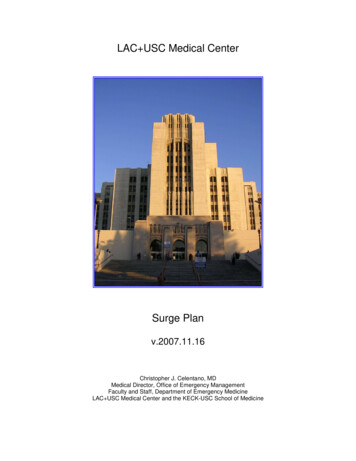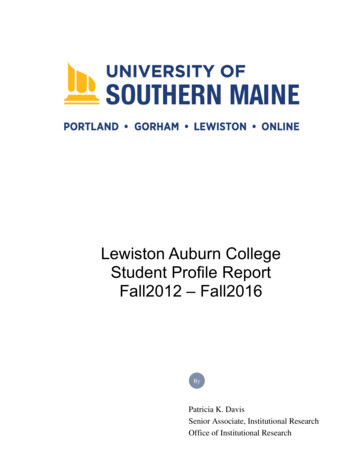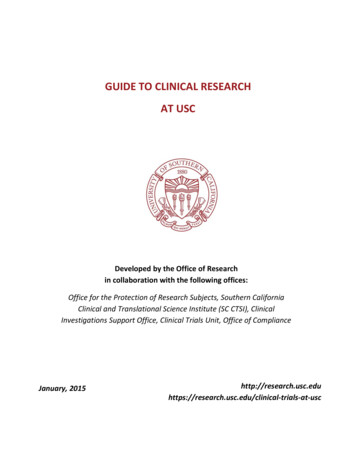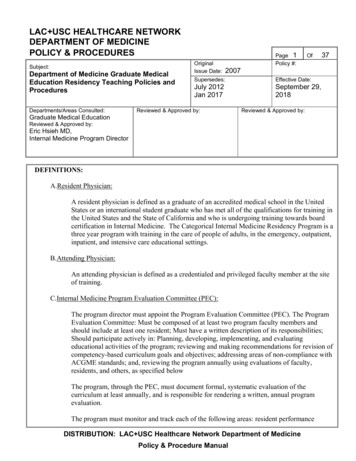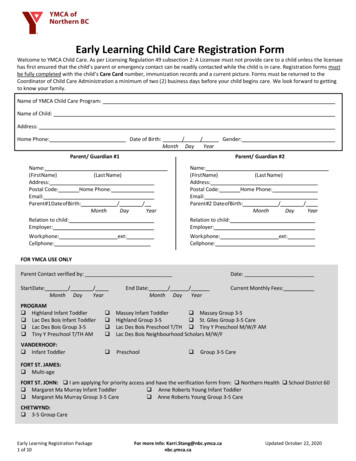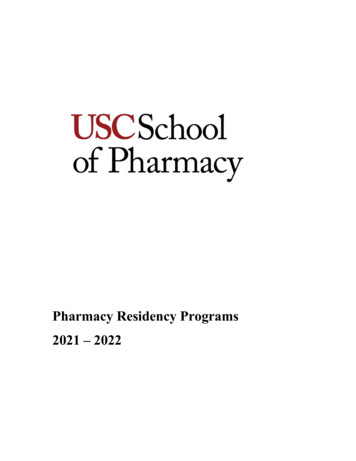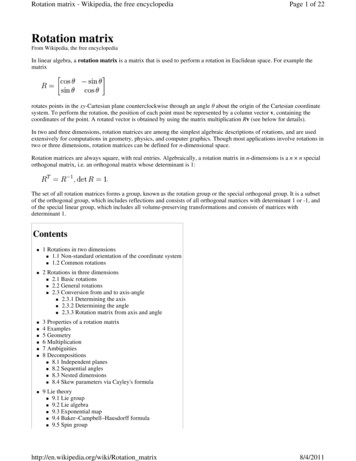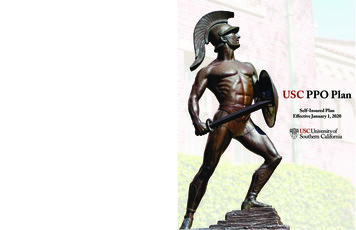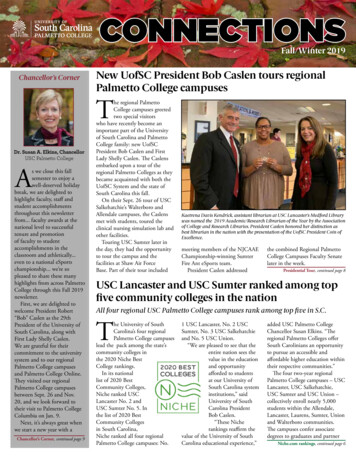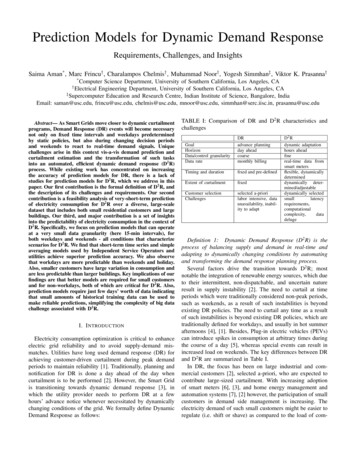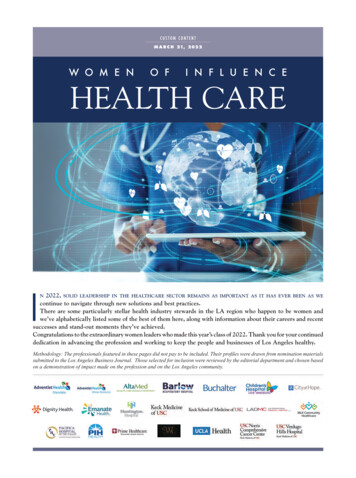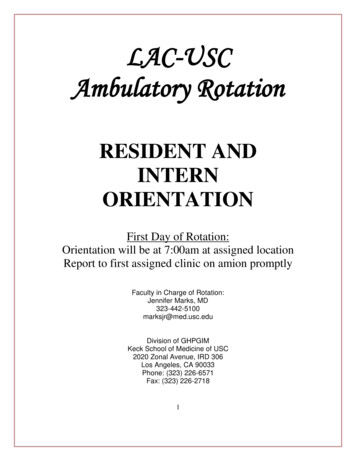
Transcription
LAC-USCAmbulatory RotationRESIDENT ANDINTERNORIENTATIONFirst Day of Rotation:Orientation will be at 7:00am at assigned locationReport to first assigned clinic on amion promptlyFaculty in Charge of Rotation:Jennifer Marks, MD323-442-5100marksjr@med.usc.eduDivision of GHPGIMKeck School of Medicine of USC2020 Zonal Avenue, IRD 306Los Angeles, CA 90033Phone: (323) 226-6571Fax: (323) 226-27181
DAILY SCHEDULE8:00 AM – 12:00 PM12:00 PM – 1:00 PM1:00 PM – 1:30 PM1:30 PM – 5:30 PMMorning ClinicLunch/Conference (Grand Rounds,M&M etc)Primary Care Clinic DidacticsAfternoon ClinicWEEKLY 8am-9amMorning ClinicCheck amion for assignment/locationAfternoon ClinicCheck amion for assignment/locationMorning ClinicCheck amion for assignment/locationAfternoon ClinicCheck amion for assignment/locationMorning ClinicCheck amion for assignment/locationAfternoon ClinicCheck amion for assignment/locationMorning ClinicCheck amion for assignment/locationAfternoon ClinicCheck amion for assignment/locationMorning ClinicCheck amion for assignment/locationNoon-1:00pmMedicine Grand Rounds, IPT, Conference Room B.1pm-5pmAfternoon ClinicCheck amion for assignment/location2
Ambulatory Rotation Conferences1. Clinic Didactic SessionsThese sessions start at 1pm weekly before the afternoon clinics commence. Pleasecheck amion and email for assignments of presentations.3
IMPORTANT PHONE NUMBERS/CONTACT INFOMedicine TeamsMed Consult 91644RARichard RCMarietta94145 9216194147 95213RBJuneRDVivian94146 9521694148 95212GAGloriaGCAda94013 9521194150 92164GBAnacleto GDSheila93987 9216394151 91479WATachilWCMarion94109 9216294154 95217WBPaulWDLupe94153 9521894155 95215MICU A 93984MICU B 93986MICUFellow 93992GI work room: 92679GI Lab/Scheduling: 95530HEME/ONCHeme consult: 323-226-6969Onc consult: 323-226-6395Pain 213-919-8545 or 97483Rad Onc: 95019 appt 95023ID:Consults: 323-226-3851TB control: 323 226 7962Epidemiology:96645Rand Schrader clinic 323-343-8255HIV clinic (5P21) 323-343-8258PALLIATIVE: 98532Medicine Subspecialty ConsultsALLERGY: 323-226-3813PULM:Consults: 91599Bronch Suite 94730Sleep Lab 97936CARDIOLOGY:Cards Consult: 93982 CCU VOIP: 93981Cath lab: 95284, 95783, 97601CathRecovery: 95284Nuc Med: 97468Stress Lab Marci:97468EKG tech: 97466, 96705Echo: 97444 Tech 97445. Read: 97520,97855RENAL:Renal consult: call VOIP for fellow ARenal fellow VOIP: A 93996, B 93997HD charge nurse VOIP: 93243RHEUM: 323-226-7889immuno lab: 97141ENDOCRINE: 323-442-2807RheumTOX: 97028GERIATRICS: 323-226-3638Neurology / PsychiatryNeuro routine consult: (323) 340-0633Neuro emergency consult: 96086GI/LIVERConsults: 979744
ED:Resus 96711 North 96707 West 93750East 97095Resus 2* 91615Res 91619Int91617North 2* 91625 Res 91659; Int 91628, 91629West 93750 Psych ED 97085ED Obs 97229SOU 97728/97729Neuro resident VOIP: 94536 Neuro wardsVOIP: 94537EEG: 97388Psychiatry: through OrchidPsych Workroom 96352Surgical ConsultsACS consults: 97728 (ACS non-trauma VOIP97769)ACS A 94737 ACS B 94736(213-919(213-9198751)8752)ACS C 94741 ACS D 94752(213-919(213-9198755)4529)Burns: 97996Cardiothoracic: 97819 NP 213-717-3593Colorectal: 213-919-7363ENT 213-919-7000 7G: 97309HBS: 213-919-8749MIS: 213-919-8581NSGY ICU: 97405Neurosurgery pager: (323) 340-0455OB/Gyn: 94198Gyn-Onc: 213-9190468OMFS: 213-217-0215 OMFS Resident Rm91558Ophtho: 213-919-9254 / Inpt clinic 6C 97225 /Outpt clinic 95227Ortho: 97227; 213-919-3487, Ortho On Call213-208-1193Plastics: 213-919-7299SICU: 91817 – consults for PEG/TrachsSurg Onc: 323-226-4981Thoracic Foregut: 323-260-0148Tumor/Breast: 213-990-8574Urology: 213-919-2156/Workroom: 96995Vascular: 213-919-8750Vasc Lab: 94618AncillaryAuthorization code for long distance calls:2112039280Dietician/Nutritionist: 96901Dynamics Orthotics 213-383-921Home O2 Eval: Amber 323-729-1462Inpatient Translator 93600IT: 98000Pager operator: 94906PICC nurse: 94186, 90779 // 94802PT/OT: 97437 Weekends: 95096Rancho liaison (Edith): 91333 Ranchoadmission: 562-401-6554RT: 92216Speech Therapy: 95082SW main: 95253SW Inpatient: 97448 SW ED: 96883SW Substance Counseling 95363SW weekends/nights: 213-919-7063Transport: 97348ICU transport: 95327Nurse Manager 91688 Supervisor: 92965UR Inpatient: 92962 UR ED: 95001Labs/PathologyBlood Bank 97134Core: 97039 Micro 97012 Cyto 91378Cytology/FNA biopsy: 94615Heme (get smears): 91804Pathology 94606Phlebotomy 97040Pharmacy5
MICU Pharm: 93936 MICU Pharm: 91888Discharge Pharm: 97165TPN: 97438Anticoag: 97606Anticoag Clinic: 95181Chemo: 97551Inpt Pharm: 97641CCU Pharm: 93730Radiologytrojanimaging.com LAC USC Radiology DirectoryClinics/Outpatient PharmacyAdult Primary Care East: 94051 (4p81), 94054 (4p61)Clinic Tower Pharmacy: 91893OPD Zonal Pharmacy: 96763Wards1E Jail 94568 Jail Command Ctr 213-893-55442E 963553C 933544AL 939294AH 93933 4BL 974904BH 940054C 974054D 971114M 97112, 971135A 973915F 973935BL 956375BH 980505C 978196A 977306B 978126C 972256D 972277A 925927B 940217C 973127D 973048A 976518B 927468A Res Lounge: 98652AdministrativeChief On Call: 213-375-4455Chief’s Office: 323-409-7644; 96625, 96626, 96627Office of educational affairs: 323-409-75566
GOALS AND LEARNING OBJECTIVESFirst Day on Service:A combined orientations will be delivered to the Interns and Seniors on the first morning of the rotation. Thelocation and time will be emailed to all trainees before the first day on the ambulatory blockFaculty in Charge of Rotation:Patrick Sarte, MD323-409-6630 / psarte@med.usc.eduOverview:You will be participating in a variety of primary care and subspecialty clinics during this rotation. Depending onyour assignment, you may also be assigned vacation time, resident replacement, as well as night float blocks.Check amion for details regarding specific assignments during the month. You may be scheduled for a dayfloat shift in the afternoon (note – this only applies to senior residents for July and August). You are expectedto arrive at the hospital at 3:00pm. You will admit patients for the medicine teams from 3:00pm to 5:30pm. Youwill have a cap of 5 admissions. Please sign out the admissions to the night float resident who is covering thespecified team. Your supervising attending is the attending of the day on amion.Morning clinics start at 8:00 am (in general) and afternoon clinics at 1:00 pm. You will experience a variety ofsubspecialty clinics as well as continuity clinics. During the afternoon sessions, you will be responsible forseeing patients who are there for nurse visits, pre-op evaluations, ER follow-ups, and hospital discharges. Withthe group practice model in place, you are part of the team at your clinic locations and should help out theother residents accordingly. As with any rotation with clinical duties, you need to inform the Chief Residentsany time you will be missing any clinical experience. It is also appropriate to inform the clinics, but itis absolutely mandatory to notify the Chief Residents.During your continuity clinic, you will participate in coordination of care among health care settings. By utilizingour EMR, you will be able to participate in the management of patients between outpatient visits. When youare on vacation, your proxy partner/clinic resident group will be available to provide coverage of results andmessages. Patient slots are available for urgent issues that arise, as well as appointments at the UADC.Location and Patient Characteristics:The ambulatory block is at the LAC-USC hospital clinics The patient population at LAC USC Medical Center isvery diverse, with multiple ethnic and socioeconomic groups represented. The spectrum of these encounterswill be from primary presentation of new disease processes, chronic diseases, acute presentations of illness.You will be serving in both the primary care and consultative role for these patients, depending on theassignment.Educational Methods:Preceptoring by faculty will be done multiple times throughout each clinical encounter. After initial evaluation ofa patient by the trainee, presentation to the supervising attending will occur. It is during this timeframe, that thesupervising attending reviews and critiques the resident’s interpretation of diagnostic studies and formulation ofassessments and plans.You will also have direct observations of the patient care encounter during the year.Evaluation Methods:You will be required to submit patient logs for each assigned clinic half day. This will be factored into yourmilestone evaluations under the categories of efficiency and professionalism. Please submit your evaluationsto the IRD 624 within 3 days of your last scheduled clinic assignment7
LEARNING OBJECTIVES FOR TRAINEESAMBULATORY CARE BLOCK ROTATIONSAIDSCompetencies for Acquired Immune Deficiency SyndromeThe resident is expected to:1) Order Labs/screening tests in a newly diagnosed HIV/AIDS patient.2) Identify the different classes of anti-virals.3) Know the correct approach to an HIV patient with fever.4) Manage the screening and treatment of latent tuberculosis infection in an HIV patient.5) Identify the AIDS defining diseases.6) Distinguish ethical and legal issues—informing sexual partners of patients with HIV and AIDS.ALLERGYCompetencies for AllergyThe resident is expected to:1) Distinguish the indications for allergy testing.2) Identify the treatment strategies for seasonal allergic rhinitis.3) Recognize asthma—establishing diagnosis and treatment.4) Distinguish how and when to treat hypogammaglobulinemia.5) Identify pre-treatment regimens for patients who have documented or suspected allergy to contrast.6) Manage penicillin allergy testing and the desensitization process.BREASTCompetencies for Women’s HealthThe resident is expected to:1) Perform breast examination including axillary lymph node assessment.2) Manage the work-up for unilateral mastalgia in a patient with a recent negative mammogram and anormal physical exam.3) Perform breast cancer screening in a patient with breast implants.4) Recognize the different skin changes associated with breast malignancies.5) Manage the evaluation and treatment of mastitis.6) Perform breast cancer surveillance in a patient who has undergone mastectomy for breast cancer.8
CARDIOLOGYCompetencies for Cardiovascular MedicineThe resident is expected to:1) Recognize the New York Heart Association’s classification of congestive heart failure.2) Understand the role of beta blockers in the treatment of CHF.3) Understand the difference between systolic and diastolic dysfunction.4) Recognize the treatment modalities for congestive heart failure secondary to diastolic and systolicdysfunction.5) Identify the major clinical and laboratory signs of endocarditis.6) Dispense antibiotic prophylaxis for endocarditis in patients undergoing dental procedures.7) Approach to the patient with newly diagnosed atrial fibrillation.8) Recognize the different anti-anginal mediation and their mechanisms of action (beta-blockers,nitrates, calcium channel blockers).9) Indications for coronary artery bypass graft.10) Recognize the different modalities to diagnose coronary artery disease.CHEST X-RAYCompetencies for Chest X-RayThe resident is expected to:1) Recognize the systematic approach to reading a Chest X-Ray.2) Differentiate a RML infiltrate from a RLL infiltrate.3) Understand the limitations of an Anterior/Posterior view of a Chest X-Ray.4) Determine if a pleural effusion layers.5) Recognize pulmonary vascular congestion, pulmonary edema, atelectasis, pleural effusion, cavitarylesions, and air bronchograms.6) Approximate the location of catheter tips.7) Identify the indications for a lateral view Chest X-Ray (LAC USC Medical Center only).DERMATOLOGYCompetencies for DermatologyThe resident is expected to:1) Recognize the major steroid responsive dermatoses seen in outpatient medicine. (allergic contact,atopic, insect bites, irritant, lichen simplex chronicus, nummular eczema, rhus dermatitis, seborrheic,stasis, dyshidrotic eczema, psoriasis.2) Ascertain the characterization of and treatment modalities for acne.3) Perform a punch biopsy, shave biopsy and excisional biopsy.4) Recognize the clinical features of melanoma, actinic keratosis, basal cell carcinoma, and squamouscell carcinoma.5) Diagnose and treat of seborrheic dermatitis.6) Perform a potassium hydroxide (KOH) prep of a skin scraping.7) Distinguish between eczematous and fungal dermatitis.9
DERMATOLOGYCompetencies for DermatologyThe resident is expected to:1) Recognize the characteristics of KS skin lesions.2) Identify the most common dermatoses affecting HIV/AIDS patients.3) Understand the difference between scabies and Norwegian scabies.4) Manage treatment modalities for condyloma acuminate/lata.5) Identify the chronic suppressive therapies for HSV.6) Recognize and manage the treatment for molluscum contagiosum.ENDOCRINOLOGYCompetencies for EndocrinologyThe resident is expected to:1) Recognize the different insulin analogs with respect to their peak onset of action, dosing schedules,compatibility with other agents.2) Identify the clinical presentations of pituitary tumors.3) Manage the treatment of prolactinomas.4) Perform a Cosyntropin stimulation test.5) Manage out-patient screening of adrenal insufficiency in patients who are on steroids.6) Ascertain the work-up for hirsutism.7) Diagnose and manage the treatment of polycystic ovarian syndrome.8) Identify the screening process for Cushing’s syndrome.9) Identify the screening process for pheochromocytoma.10) Effectively approach the patient with Galactorrhea.11) Learn how to examine the thyroid and obtain a history directed toward possible thyroid illness.12) Understand the use and interpretation of basic tests of thyroid function.13) Understand the therapeutic approach the hyper- and hypothyroidism.PRIMARY CARE/ GENERAL MEDICINECompetencies for General MedicineThe resident is expected to:1) Perform age appropriate cancer screening.2) Administer age appropriate immunizations.3) Diagnose obesity and the metabolic syndrome. Be able to calculate BMI. Identify treatmentstrategies including approaches to diet control and indications for bariatric surgery.4) Identify domestic violence screening/intervention.5) Perform alcohol/substance abuse screening.6) Identify JNC VII guidelines for diagnosis and treatment of hypertension.7) Identify NCEP guidelines for treating hyperlipidemia.8) Identify and administer vaccines for traveling outside the United States.10
HEMATOLOGYCompetencies for HematologyThe resident is expected to:1) Manage the evaluation of a patient with thrombocytopenia.2) Distinguish between normal and abnormal red blood cells on a peripheral smear.3) Diagnose and manage treatment of anti-phospholipid syndrome.4) Identify the major factor/co-factor deficiencies and their associated risks for bleeding and thrombusformation.5) Manage the treatment of a patient with a prolonged protime or prothrombin time.6) Diagnose and manage the treatment of pernicious anemia.7) Distinguish between primary and secondary polycythemia.8) Identify the diagnostic criteria for myelodysplastic syndrome and the subtypes of this condition.HEPATITISCompetencies for HepatitisThe resident is expected to:1) Manage the appropriate work-up for a patient who tests HCV antibody positive.2) Identify the risk factors for hepatitis B and C.3) Identify the major side effects of alfpha-interferon and ribavarin.4) Understand the factors that are taken into consideration before considering someone a candidate forinterferon based antiviral therapy.5) Administer appropriate lifestyle counseling for a patient who is newly diagnosed with chronic viralhepatitis.6) Identify the indicated immunization schedule for a patient who tests positive for hepatitis B and C.7) Interpret the different serologic tests for hepatitis B and C.LIVERCompetencies for Liver DiseasesThe resident is expected to:1) Identify the screening tests available to establish the diagnosis of hemochromotosis.2) Ascertain how to diagnose and treat non-alcoholic fatty liver disease.3) Distinguish the basic approach to a patient who is referred for evaluation of elevated liver enzymes.4) Identify the Child’s-Pugh classification of liver cirrhosis.5) Recognize the indications and for liver transplantation including fulminant hepatitis.6) Identify the risk factors and treatment of hepatic encephalopathy in a cirrhotic patient.7) Understand the significance of the serum-ascites albumin gradient (SAAG).8) Ascertain the major causes of high and low SAAG ascites.9) Identify how to diagnose and treat spontaneous bacterial peritonitis.10) Classify the indications for antibiotic prophylaxis in a patient with ascites.11) Classify the indications for TIPS procedure.11
NEUROLOGYCompetencies for Neurology:The resident is expected to:1) Diagnose and identify the treatment of Bell’s palsy.2) Perform a rapid, comprehensive neurologic exam and stroke risk assessment.3) Identify risks and benefits of different anti-platelet agents in primary and secondary stroke prevention.4) Diagnose and identify the treatment of carpal tunnel syndrome.5) Identify the presenting signs and symptoms of Multiple Sclerosis.6) Diagnose and identify the management of restless leg syndrome (periodic limb movement disorder).7) Recognize the presenting signs and symptoms of Parkinson’s disease.ONCOLOGYCompetencies for OncologyThe resident is expected to:1) Recognize the significance of the BRCA1 and BRCA2 gene mutations.2) Identify pain management in cancer patients.3) Assess performance status.4) Identify neutropenic precautions.5) Manage the treatment of anemia and leukopenia in patients undergoing chemotherapy.6) Identify treatment options for nausea in patients undergoing chemotherapy.7) Recognize and manage oncologic urgencies/emergencies including tumor lysis, hypercalcemia,neutropenic fever, cord compression, and brain metastases.OPHTHALMOLOGYCompetencies for OphthalmologyThe resident is expected to:1) Know which patients presenting with “red eyes” need emergency referrals.2) Recognize how to differentiate between bacterial, allergic and viral conjunctivitis and how to treat eachcondition.3) Diagnose and identify treatment of corneal abrasions (flourescein eye exam.)4) Identify and know how to treat chalazions.5) Recognize the signs and symptoms of acute narrow angle glaucoma.6) Perform the following procedures—fundoscopy, fluorescein eye exam, visual field testing, tonometry.7) Identify and manage the treatment of blepharitis.OTOLARYNGOLOGYCompetencies for Otolaryngology:The resident is expected to:1) Perform cerumen removal by curette extraction and water lavage.2) Identify and and differentiate anterior versus posterior epistaxis and manage anterior bleeds with use ofsuction, intra-mucosal anesthetics containing epinephrine, nasal tampons, anti-hypertensives, analgesicsand antibiotics.3) Evaluate and identify the management of a patient with chronic cough.4) Approach the patient with subjective hearing loss.5) Evaluate and manage the treatment of tinnitus.6) Recognize and identify the treatment of benign positional vertigo—Epley maneuver.12
7) Identify and manage treatment of nasal polyps.8) Approach the patient with rhinosinusitis.9) Diagnose and manage periorbital cellulitis.PULMONARYCompetencies for PulmonaryThe resident is expected to:1) Classify the work-up of a patient with newly diagnosed restrictive lung disease.2) Recognize the indications for inhaled steroids and beta agonists in patients with chronic obstructivepulmonary disease (COPD.)3) Identify the classifications of asthma and the appropriate treatment modalities.4) Recognize the signs, symptoms, and management of central/obstructive sleep apnea.5) Distinguish the indications for home oxygen.6) Identify the radiographic signs of interstitial lung disease and chronic obstructive pulmonary disease(COPD.)7) Diagnose and manage a patient with a solitary pulmonary nodule.RHEUMATOLOGYCompetencies for RheumatologyThe resident is expected to:1) Recognize the radiographic features of rheumatoid arthritis.2) Be familiar with the diagnostic criteria for systemic lupus erythematosus (SLE.)3) Diagnose and manage the treatment of Gout.4) Recognize the different disease modifying anti-inflammatory medications for treatment ofrheumatoid arthritis and their major side effects.5) Identify the characteristics of synovial fluid from degenerative, traumatic, inflammatory andinfectious joints.Understand the significance of various auto-antibodies in the ANA panel used in the diagnosis ofconnective tissue disseases13
LAC-USC AMBULATORY MILESTONES PER TRAINING YEARPGY 1 :Patient CareHistorical Data Gathering Consistently acquires accurate and relevant histories from patients Seeks and obtains data from secondary sources when neededPerforming a physical exam Consistently performs accurate and appropriately thorough physical exams. Identify pertinent abnormalitiesusing common maneuversClinical Reasoning Uses collective data from history, exam, laboratory and imaging studies to identify each patient’s central clinicalproblem Develops a valid differential diagnoses for the patient’s central clinical problem, using evidence based guidelines Makes proper real-time clinical decisions when informed by ancillary staff of findings such as vital sign changes,laboratory abnormalities, imaging findings, EKG results Makes proper real-time clinical decisions in response to consultant recommendationsPatient Management Recognize situations with a need for urgent or emergent medical care including life threatening conditions Seeks additional guidance and consultation from supervising residents and attendings when needed Provides appropriate patient counseling during hospitalization, and delivers patient education at time ofdischarge Carries out agreed upon care plan in a timely and efficient fashion, ensuring patient safety and quality care(including patients with multiple diagnoses) Work with medical student to provide patient care, but does not directly supervise When supervised, can demonstrate the appropriate technique for the following procedures: paracentesis,thoracentesis, lumbar puncture, arterial blood gas sampling Consistently obtains informed consent for the aforementioned proceduresMedical KnowledgeKnowledge of core content Understand the relevant pathophysiology for common inpatient medical conditions Demonstrate sufficient knowledge to diagnose common conditions that require hospitalization.Diagnostic tests Understand basic interpretation of common diagnostic testing, including laboratory abnormalities, imagingfindings, EKG results and other pertinent studies Can identify the indications, contraindications for each of the aforementioned procedures14
Systems Based PracticeWorks effectively within an interprofessional team Appreciate roles of a variety of health care providers, including, but not limited to, consultants, therapists,nurses, pharmacists, care coordinators and social workers Works closely with the assigned care coordinator for the inpatient team Work effectively as a member within the interprofessional team to ensure safe patient careWorks effectively within multiple health delivery systems Understand unique roles and services provided by local health care delivery systems Understands the services available to underserved patients within the communityRecognizes system error and advocates for system improvement Recognize health system forces that increase the risk for error including barriers to optimal patient care Identify, reflect upon, and learn from critical incidents such as near misses and preventable medical errors andnotify supervisor accordingly Open to feedback regarding specific decisions that could lead to error or harmIdentifies forces that impact the cost of health care and advocates for cost-effective care Open to feedback from EMR and care coordinator on documentation of intensity of service and clinical necessityDemonstrates awareness of common socio-economic barriers that impact patient careMinimize unnecessary care including tests, procedures, and therapies for hospitalized patientsTransitions patients effectively within and across health delivery systems Recognizes the importance of accurate, on-time and updated handovers during transitions of care Communicates to all accepting caregivers in a timely and pertinent fashion Works effectively with care coordinator to transfer patients with accurate and pertinent documentation in atimely mannerProblem Based Learning and ImprovementMonitors practice with a goal for improvement Understands the importance of self-reflection of one’s practice and performanceLearns and improves via performance audit Understands the importance of using information gathered from an audit to improve one’s practiceLearns and improves via feedback. Respond welcomingly and productively to feedback from all members of the health care team.Learns and improves at the point of care Aware of the strengths and weaknesses of specific sources of medical information Can use validated medical resources to form clinical questions With assistance, appraises clinical research reports, based on accepted criteria15
ProfessionalismHas professional and respectful interactions with patients, caregivers and members of the interprofessionalteam (e.g. peers, consultants, nursing, ancillary professionals and support personnel) Consistently respectful in interactions with patients, caregivers and members of the interprofessional team Seeks assistance in challenging interprofessional situations Is available and responsive to needs and concerns of patients, caregivers and members of the interprofessionalteam Emphasizes patient privacy, confidentiality and autonomy in all interactions Respond promptly and appropriately to clinical responsibilities including, but not limited to, calls and pagesAccepts responsibility and follows through on tasks Completes administrative and patient care tasks in a timely fashion, working effectively with care coordinatorsCompletes assigned professional responsibilities without the need for remindersCompletes all assigned rotation, attending and peer evaluations in a timely fashionDress and behave appropriatelyResponds to each patient’s unique characteristics and needs. Seeks to fully understand each patient’s unique characteristics and needs based upon culture, ethnicity, gender,religion, and personal preference and modifies care plan accordinglyUnderstanding the specific needs of the patient population specific to our safety net institutionExhibits integrity and ethical behavior in professional conduct. Document and report clinical information truthfullyAccept personal errors, demonstrates accountability and follows formal hospital policiesInterpersonal and Communication SkillsCommunicate effectively with patients and caregivers Engages patients in shared decision making while asking for assistance in facilitating discussions in complicatedsituations Is able to engage in communication with persons of different socioeconomic and cultural backgrounds Provides empathetic, timely and accurate communication to patients/advocates Consistently uses an interpreter to communicate with patients, caregivers and family in the clinical settingCommunicates effectively in interprofessional teams (e.g. peers, consultants, nursing, ancillary professionals andother support personnel). Engages in collaborative communication with appropriate members of the team by using verbal, non-verbal, andwritten methods that facilitate care Attempts to deliver appropriate, succinct relevant presentations Presentation skills improve with feedbackAppropriate utilization and completion of health records. Health records are organized and accurate with feedback from residents and attendings16
PGY 2/3/4:Patient CareHistorical Data Gathering Acquires accurate histories from patients in an efficient, prioritized, and hypothesis-driven fashion Uses elements of the history to formulate a prioritized differential diagnosis, assessment and plan Obtain collateral information when relevant to the casePerforming a physical exam Consistently performs accurate and appropriately thorough physical exams. Identify pertinent abnormalitiesusing common maneuvers Demonstrate and teach how to elicit important physical findings for junior members of the healthcare team Performs accurate physical exams that are targeted to the patient’s complaintsClinical Reasoning Uses collective data from history, exam, laboratory and imaging studies to generate a prioritized differentialdiagnosis and problem list Effectively uses history and physical examination skills to minimize the need for further diagnostic testing Guides junior trainees on real-time clinical decision-making Recognizes complex clinical presentations and effectively coordinates care Makes appropriate decisions regarding the need for consultative carePatient Management Appropriately modifies care plans based on patient’s clinical course, additional data, and patient preferences Independently manages inpatients who have multiple active disease processes. Appropriately weighs recommendations from consultants in order to effectively manage patient care Appropriately manages situations requiring urgent or emergent care Effectively supervises the management decisions of the team Possesses technical skill and can guide junior trainees through procedures required for certification Teaches the rationale, risks and benefits associated with common procedures and anticipates potentialcomplications when performing procedures patient counseling and patient education throughout hospitalizationand at the time of discharge Carries out agreed upon care plan in a timely and efficient fashion, ensuring patient safety and quality care(including patie
Report to first assigned clinic on amion promptly . Faculty in Charge of Rotation: Jennifer Marks, MD . 323-442-5100 . marksjr@med.usc.edu . Division of GHPGIM . Keck School of Medicine of USC . 2020 Zonal Avenue, IRD 306 . Los Angeles, CA 90033 . Phone: (323) 226-6571 . Fax: (323) 226-2718
